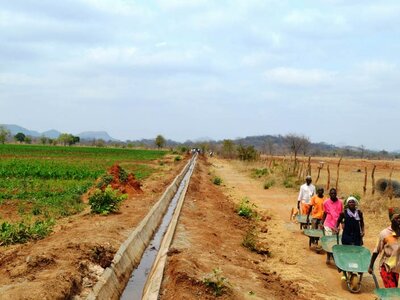Reliant on meagre resources, they lack access
to diversified diets. They also have little
opportunity to improve their
health,
education,
economic growth, or
development in the broadest
sense.
Climate change and cyclical weather extremes
have a disproportionate impact on these
settings, multiplying existing threats to food
security and nutrition. In the long term,
climate change makes natural disasters more
frequent and intense, land and water more
scarce and difficult to access, and
agricultural productivity harder to
achieve.
Deprived of
effective safety nets and social
protection systems, poor and food insecure people can neither
invest in
more sustainable agricultural
practices, nor even protect such modest resources as
they have. They will instead resort to
negative coping strategies, including
overexploiting natural resources and further
degrading the land. Two-thirds of people in
Africa are estimated to be living on land
that is degraded to some extent; globally,
around a quarter of all land suitable for
agriculture is degraded. As a result, every
new drought or
flood further depletes
people’s assets, trapping them in a spiral
of diminishing resilience and environmental
misery.
The World Food Programme (WFP) helps
countries and the most vulnerable and food
insecure communities manage natural
resources sustainably. This enables them to
meet today’s livelihood needs and safeguard
these resources for future generations. Our
interventions – involving soil conservation
and fertility measures, water harvesting and
flood control – bolster agro-ecological
productivity and reduce the loss of
biodiversity. We rehabilitate irrigation
schemes and develop water sources for
domestic use, for agriculture and
aquaculture, and for livestock rearing;
improve forestry and agroforestry management
through afforestation, tree nurseries and
seed collection; cut overgrown vegetation in
abandoned and previously cultivated areas;
and remove debris from agricultural areas
after floods and landslides.
Access to clean water in arid and semi-arid
contexts results in more diversified food,
thereby complementing nutrition efforts. But
as well as bringing communities closer to
Zero Hunger, the restoration of degraded
ecosystems boosts public health and reduces
hardship in general. The availability of
water and firewood closer to home, for
example, reduces the need for women and
girls to travel long distances to collect it
– a common chore, which has been proved to
expose them to harm.
Food Assistance for Assets
(FFA) activities are closely integrated with
related climate, smallholder and engineering
activities, to ensure that assets such as
rehabilitated feeder roads and bridges,
schools, latrines, water reservoirs, market
places, storage facilities and fuel
efficient stoves all contribute to improved
physical access to markets and services and
improved access to energy. Where feasible
and appropriate, under our FFA programme, we
transfer the responsibility for carrying out
these tasks to our beneficiaries themselves
– in effect, assisting them to develop and
manage their own assets. As they build up
their own nutritional status and communal
wellbeing over the long term, vulnerable
households receive food and cash assistance
to cover their immediate food needs.







